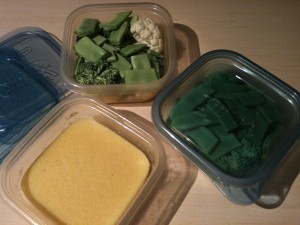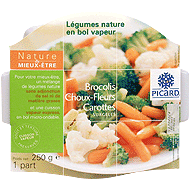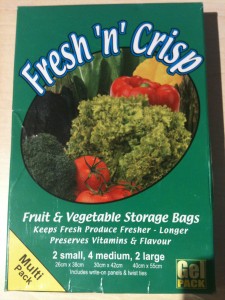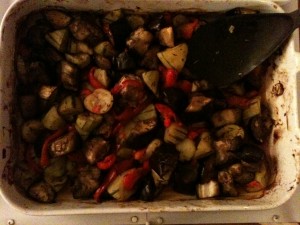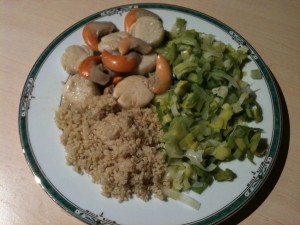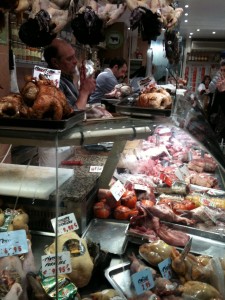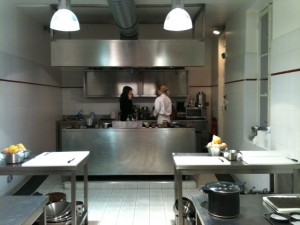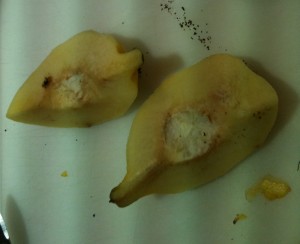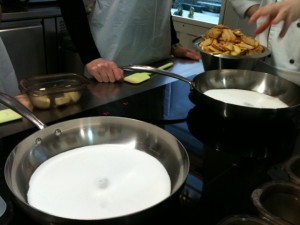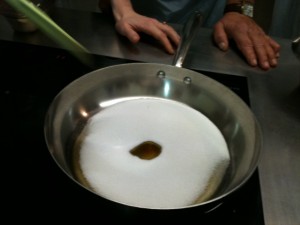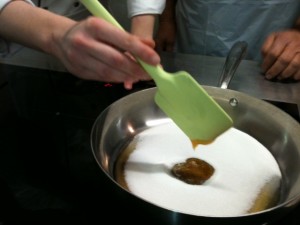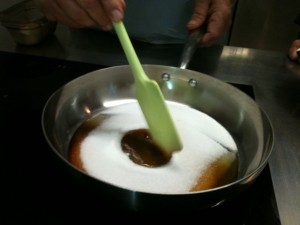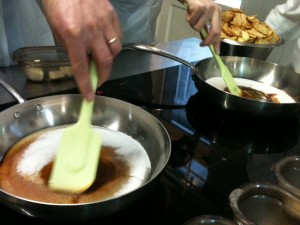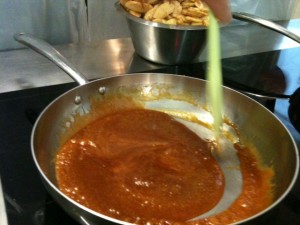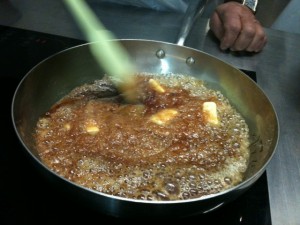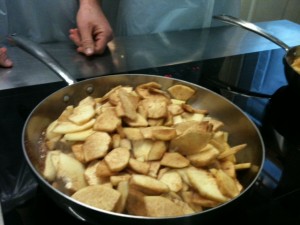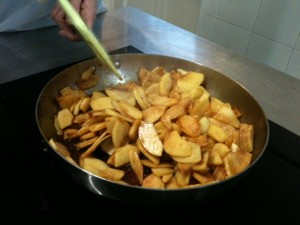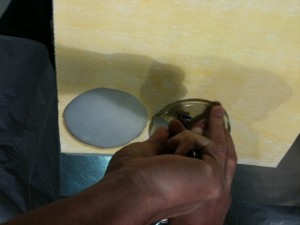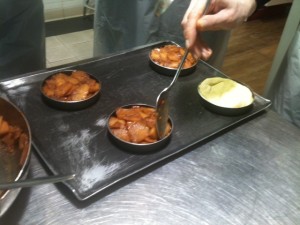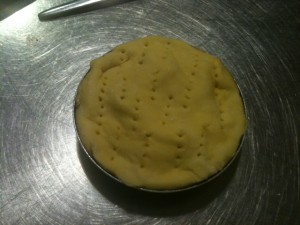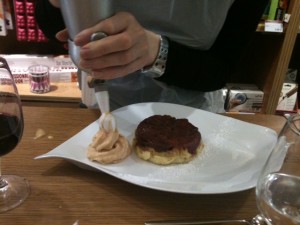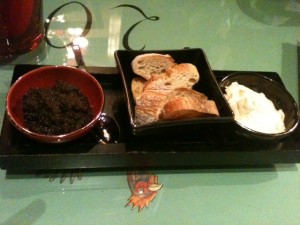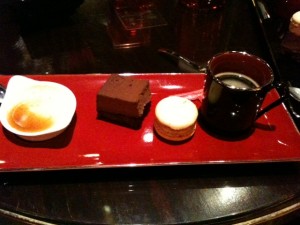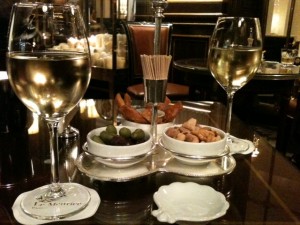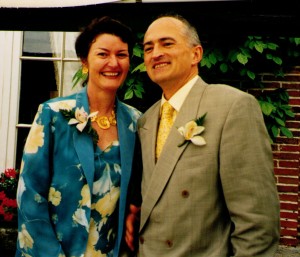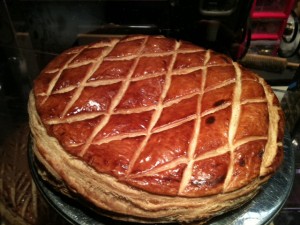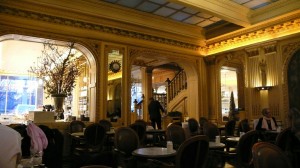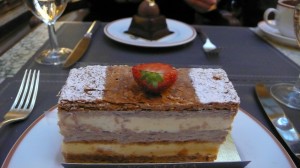 A little bit late, but here it is! Chandeleur or, more popularly, “la fête des crèpes” is held on 2nd February, 40 days after Christmas. One explanation is that it celebrates the presentation of Christ at the temple of Jerusalem but it seems there are pagan origins as well. Its name derives from the expression “festa candelarum”or “candle day”. It seems there’s also a tradition of holding a coin in your hand when flipping the crèpe that will guarantee prosperity for the coming year.
A little bit late, but here it is! Chandeleur or, more popularly, “la fête des crèpes” is held on 2nd February, 40 days after Christmas. One explanation is that it celebrates the presentation of Christ at the temple of Jerusalem but it seems there are pagan origins as well. Its name derives from the expression “festa candelarum”or “candle day”. It seems there’s also a tradition of holding a coin in your hand when flipping the crèpe that will guarantee prosperity for the coming year.
In any case, everyone loves crèpes so any excuse is good!
Ingredients:
250 g of flour (I use wholemeal) 2 or 3 eggs 1/2 litre of milkThe trick for not getting lumps in the mixture is to put the flour in first, then the eggs. With a wooden spoon, break the yolks and mix the eggs a bit, then add enough milk to be able to mix it all to a thick, but not dry, paste, then add the rest of the milk in stages. If you don’t add enough milk the first time, you get lumps. I don’t add sugar to the mixture, but some recipes do (about 100 g sugar for 250 g flour).
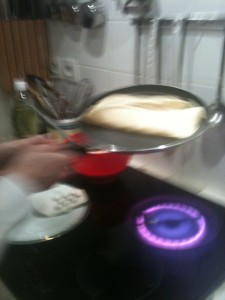 Add a teaspoon of oil and stir. Then add a bit of water so that the consistency is right. This will depend on your flour and number of eggs. It has to be thick but runny at the same time. You can readjust the texture after the first crèpe. A lot of people in France think the mixture has to “rest” for hours beforehand but it’s only because they don’t know how to make it without lumps. Leaving it for hours takes the lumps out.
Add a teaspoon of oil and stir. Then add a bit of water so that the consistency is right. This will depend on your flour and number of eggs. It has to be thick but runny at the same time. You can readjust the texture after the first crèpe. A lot of people in France think the mixture has to “rest” for hours beforehand but it’s only because they don’t know how to make it without lumps. Leaving it for hours takes the lumps out.
It’s best to use a flat crèpe pan but a frypan still works. I now buy Teflon because it’s so much easier even though it gets a lot of flak these days. You just have to replace it when it gets scratched, which won’t happen if you flip the crèpes. One of the problems with the regular pans is that the bottom has a tendency to to rise up in the middle after a while and the crèpe doesn’t cook evenly.
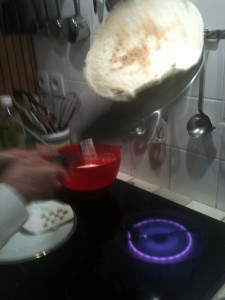 In any case, you need to have the pan very hot to start with. We specifically bought a cooker top with a halogen ring so we could cook crèpes! I used to have gas which is much better. So, you add a little oil to the pan and spread it on the bottom with a paper towel. Using a ladle, pour in just enough mixture to cover the bottom of the pan. This will obviously take practice but, don’t worry, the crèpes will get eaten anyway, even if they’re too thick or too thin! Swirl the mixture rapidly around the pan by tilting it a bit. Some people use wooden scrapers to make them very thin but I’ve never tried. Maybe I should. When the bubbles burst on the top and you can see that the crèpe has shrunk away from the sides, use a spatula to make sure it isn’t stuck to the pan. When the crèpe can slide around easily, it’s ready to flip. With a deft flick of the wrist (don’t you like that description), preferably using two hands, flip the crèpe. Of course, you should make sure that if it misses the pan on the way down, it doesn’t fall into the rest of the mixture.
In any case, you need to have the pan very hot to start with. We specifically bought a cooker top with a halogen ring so we could cook crèpes! I used to have gas which is much better. So, you add a little oil to the pan and spread it on the bottom with a paper towel. Using a ladle, pour in just enough mixture to cover the bottom of the pan. This will obviously take practice but, don’t worry, the crèpes will get eaten anyway, even if they’re too thick or too thin! Swirl the mixture rapidly around the pan by tilting it a bit. Some people use wooden scrapers to make them very thin but I’ve never tried. Maybe I should. When the bubbles burst on the top and you can see that the crèpe has shrunk away from the sides, use a spatula to make sure it isn’t stuck to the pan. When the crèpe can slide around easily, it’s ready to flip. With a deft flick of the wrist (don’t you like that description), preferably using two hands, flip the crèpe. Of course, you should make sure that if it misses the pan on the way down, it doesn’t fall into the rest of the mixture.
 Otherwise you can turn it with a spatula and when the other side is cooked, you can practice flipping. That way, if you don’t throw it up high enough, it won’t stick to itself on the way down.
Otherwise you can turn it with a spatula and when the other side is cooked, you can practice flipping. That way, if you don’t throw it up high enough, it won’t stick to itself on the way down.
When my kids were small and invited their friends over, I used to keep making crèpes until no one wanted any more. They loved the ones with holes. One of Black Cat’s friends used to eat bits out at eye level and pretend it was a mask then eat it bit by bit. I once made them for 2 hours straight at a school fête. It was the most popular stand!
Don’t forget to subscribe to new posts – that way you’ll get them directly on your smart phone or in your mail box! And I love to hear your comments!





